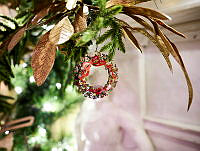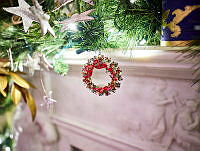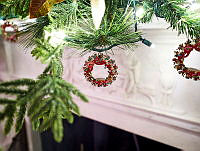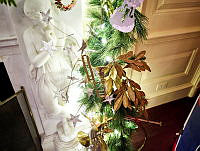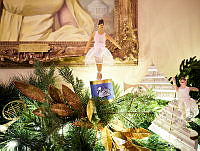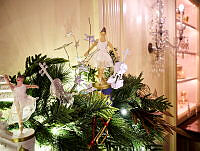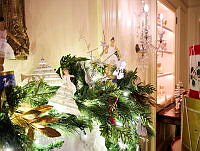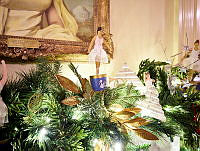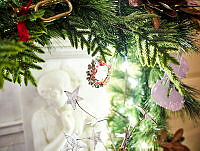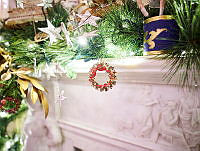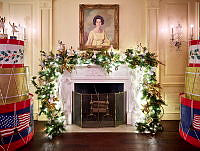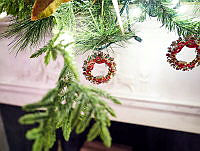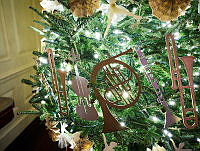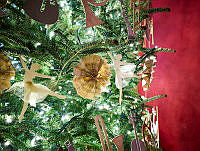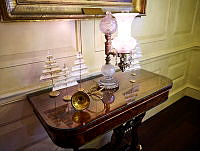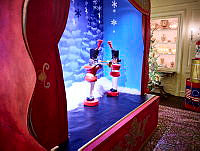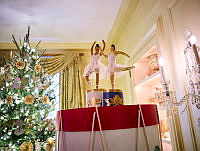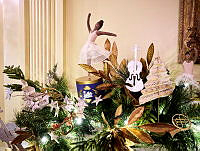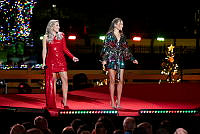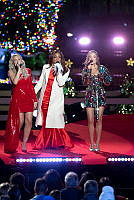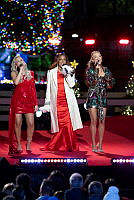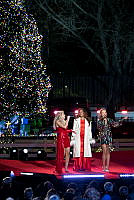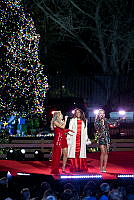Rubenstein Center Scholarship
Distinguished Cellists in the White House

Pianist Mieczyslaw Horszowski, cellist Pablo Casals, and violinist Alexander Schneider rehearse in the White House Diplomatic Reception Room before performing in the East Room on November 13, 1961.
John F. Kennedy Presidential Library and Museum/NARAThe White House has hosted many musical performances featuring artists playing a wide variety of instruments. When the first cello—an instrument dating originally from the sixteenth century and also called the violincello—passed through the doors of the Executive Mansion remains uncertain. The first great showcase performance there to feature the instrument, however, took place on January 15, 1904, when twenty-seven-year-old Spanish cellist Pablo Casals entertained President Theodore Roosevelt and his family at a reception in the East Room.
Casals, who hailed from Barcelona, established a reputation throughout Europe as a brilliant cellist when he was barely out of his teens. He performed for Queen Victoria in London in 1899, and went on to amaze appreciative audiences at concerts in France and the Netherlands. He embarked on his first tour of the United States in 1901, and returned three years later for another tour that included a stop at the White House. On the evening of January 15, 1904 he attended dinner with the Roosevelts and a large crowd of guests at a table decorated with ferns and orchids. Afterwards at 10:00 in the evening, First Lady Edith Roosevelt convened her second musical of the season with the trio of Casals, basso vocalist Myron W. Whitney, Jr., and pianist Ward Stephens. Their program featured Casals performing a cello sonata by Luigi Boccherini; Le Cygne (The Swan) from The Carnival of the Animals by Camille Saint-Saëns; and Spanish Dance by David Popper. Enthusiastic journalists termed the evening a “brilliant success.” One month later Casals made his debut at Carnegie Hall in New York.1
Less famed but nonetheless accomplished cellists would appear frequently at White House performances in the years to come. On the evening of December 5, 1913, in the Green Room, First Lady Ellen Wilson presided over a musicale that included tenor Morgan Kingston, along with a quartet of women musicians led by renowned British cellist Beatrice Harrison. President Calvin Coolidge and First Lady Grace Coolidge hosted a performance on January 24, 1924, that included cellist Jean Gerardy. President Herbert Hoover welcomed cellist Gregor Platigorsky to the White House for a dinner and performance on the evening of January 14, 1932. And Beatrice Harrison returned to the White House on March 1, 1935, offering solo works by Roger Quilter, Frederick Delius, Jean Baptiste Senaillé, Édouard Lalo, and Herbert Hughes.2

Pablo Casals performs at the White House, November 13, 1961.
John F. Kennedy Presidential Library and Museum/NARAAll of these performances, however, seemed to serve as mere preludes to the return of the great Pablo Casals. In October 1961 Casals was eighty-four years old, and still adhering to a resolution he had made years earlier not to perform publicly in the capital of any country that recognized the regime of dictator Francisco Franco in his native Spain. The United States, in which Casals had performed almost yearly from 1904 until 1928 was among those countries recognizing the Spanish regime, and as a result Casals had not performed there (with the exception of a performance at the United Nations Headquarters in 1958) since fleeing Franco’s Spain in 1939. In this instance, though, Casals decided to make an exception, he told President John F. Kennedy, in order to “symbolize my deep feelings for the American people and the faith and confidence we all have in you as leader of the Free World.”3
Casals’ concert in the East Room on November 13, 1961 was among the most dramatic that the White House has ever seen. Greeting the guests—who included Luis Muñoz Marín, the governor of Puerto Rico (where Casals now lived), composer Aaron Copland, and conductors Leopold Stokowski, Eugene Ormandy, and Leonard Bernstein—the president remarked that “Music and the arts are an integral part of a free society, and the artist must be a free man.” The performance included a D Minor Trio by Felix Mendelssohn (with pianist Mieczyslaw Horszowski and violinist Alexander Schneider), an Adagio by Robert Schumann, and Five Pieces by François Couperin. The Washington Post, in an article titled “White House Bows to Immortal Casals,” enthused:
“As Casals bowed through the Schumann with steady arm, freely using every inch of the bow without a sign of insecurity, it challenged our belief in the staying power of man. His tone was rich and even, his intonation, even in wide, rising leaps, easy and centered. His sense of the romantic style of both Mendelssohn and Schumann was puissant as ever. As he finished the glowing Schumann Adagio, Casals paused for a second, and then, with the fervor of a youth just leaving his teens, he leaped upon the great sweeping phrases of the Allegro with energy and fire that held no little thrill.”4
Kennedy’s successor President Lyndon B. Johnson would award Casals the Presidential Medal of Freedom at the White House on December 6, 1963.
Other cellists would appear at the White House in the years to come, but nothing approached the Casals concert for artistry or drama until a recital given by expatriate Soviet cellist Mstislav Rostropovich in the East Room of the White House on September 17, 1978. With President Jimmy Carter, who had invited the artist, occupied to his chagrin with important discussions at Camp David, First Lady Rosalynn Carter hosted the event, which was broadcast on national television.

Mstislav Rostropovich and his daughters Elena and Olga perform at the White House on September 17, 1978.
Jimmy Carter Presidential Library and Museum/NARAAccompanied by his daughters Elena and Olga respectively as pianist and page turner, Rostropovich performed a Sonata for Cello and Piano by Dmitri Shostakovich. He then adjourned to the Blue Room where he proclaimed that he was “praying for peace with my music.”5 Rostropovich would return to the White House, including in a solo performance on June 13, 1994, for the Emperor and Empress of Japan—an event that also celebrated his seventeen years as director of the National Symphony Orchestra.6
President Ronald Reagan, who presented Rostropovich with the Presidential Medal of Freedom in a White House ceremony on June 23, 1987, welcomed rising cellist Yo-Yo Ma for a concert for the Crown Prince and Princess of Japan on October 6 of that year, which also happened to be the day before the cellist’s thirty-second birthday. But this was not his first visit to the White House. In the autumn of 1962, at age seven, Bernstein introduced Yo-Yo Ma to President Kennedy in “The American Pageant for the Arts.” Before the child performed Jean-Baptiste Bréval’s Concertino in A, Bernstein remarked: “There has come to us this year, a young man aged 7, bearing the name Yo-Yo Ma. Yo-Yo came to our attention through the great master Pablo Casals, who had recently heard the boy play the cello. Yo-Yo is, as you may have guessed, Chinese, and has lived up to now in France—a highly international type. But he and his family are now here. . . . And they are all hoping to become American citizens.”7

Cellist Yo-Yo Ma performs at the White House for President Ronald Reagan and First Lady Nancy Reagan on October 6, 1987.
Ronald Reagan Presidential Library and Museum/NARACello prodigies have since become a fixture at White House performances. President Barack Obama hosted performances by Yo-Yo Ma—to whom he presented the Presidential Medal of Freedom in 2011—and by accomplished youngsters. Alisa Weilerstein and eight-year-old Sujari Britt appeared in the East Room on November 4, 2009, collaborating in Luigi Boccherini’s Sonata for Two Cellos in C as part of an event sponsored by the President’s Committee on the Arts and the Humanities that Ronald Reagan had created in 1982. With First Lady Michelle Obama introducing the event and looking on, Britt, according to the New York Times, “played the genial melody with mature sound and shapely phrasing and, when the roles switched, nimbly dispatched the undulant accompanimental figure.” Reporters asked Weilerstein afterwards if White House events such as these—for cellists, dating back at least to President Theodore Roosevelt—would help to bring classical music to new generations of Americans. “If that doesn’t do it,” she replied, “I don’t know what does.”8

Yo-Yo Ma plays with the Marine Band String Quartet in the Entrance Hall of the White House on February 15, 2011 following his acceptance of the Presidential Medal of Freedom.
Official White House Photo by Pete Souza












